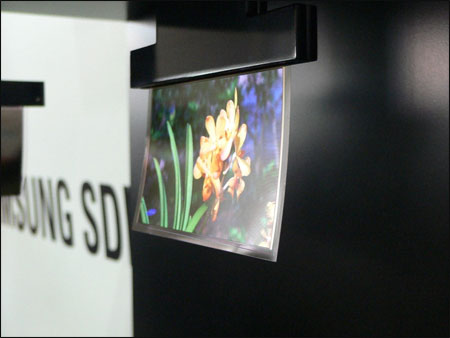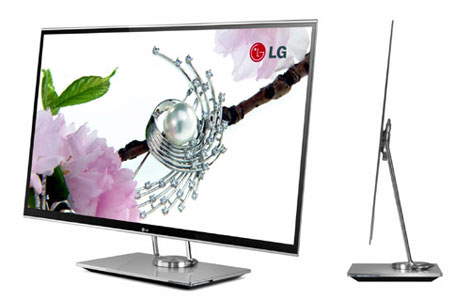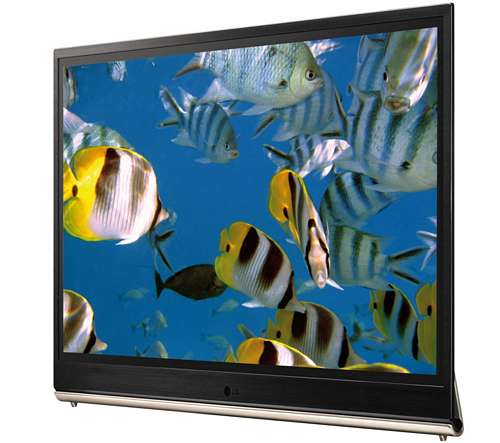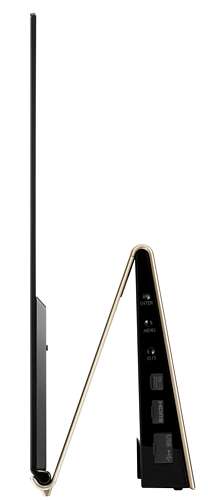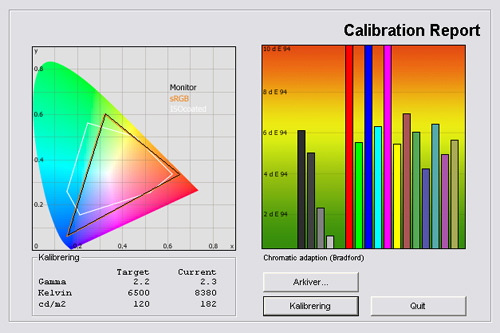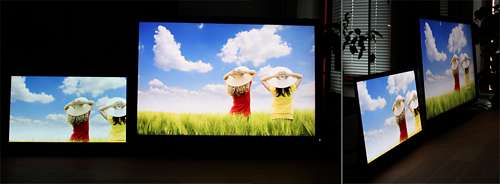Review: LG OLED-TV
LG OLED-TV review
OLED is considered the future of display technology, primarily because of its excellent picture characteristics such as perfect black, perfect viewing angles, extremely fast response time, true color depth, extremely slim frame and low energy consumption. We have received LG’s 15-inch OLED-TV EL9500 for testing and comparison to the LCD and plasma display technologies.
This is not an actual product review but instead a technology review. We want to examine picture quality on the OLED panel and thus predicting the future potential of OLED. Read on to learn more about the future of display technology. Trust me, you want to.
Subscribe to our Newsletter to receive e-mails when new reviews are online. We’ll soon publish our BenQ XL2410T, Samsung C680 3D-plasma, and Philips 9705H reviews as well.
Panel size: 15" widescreen Resolution: 1366x768 Response time: - Contrast ratio: 10.000.000:1 Brightness: - Colour support: 16,7 million colors Signal processing: 8 for each color Viewing angles (H/V): 178/178 Dot pitch: - Panel type: OLED Wall mounting: Swivel stand: Dimensions (HxBxD): - Weight - kg Built-in speakers: Input formats: 480p/i, 576p/i, 720p, 1080i & 1080p (50, 60 & 24p) 1:1 pixel mapping: Inputs • VGA • DVI (can be converted through HDMI)
• Audio (type) (Audio in/out)
• SCART • S-video • Composite • Component 
• HDMI • Andet Outputs • Audio (type) • SCART • S/PDIF Price and retailer:
| US retailer | UK retailer |
 |  |
An introduction to OLED
I want to start off by telling something about the OLED technology in general. The pictures below show different OLED panels and are not based on the LG EL9500.OLED is short for organic light emitting diode. The OLED technology is active meaning that it is able to emit light unlike the LCD technology that is dependent on backlight unit to create light. Light is emitted from the smaller OLED pixels with the help of a very thin organic film layer and a cathode and anode. And you don’t necessarily have to use glass substrates for screens, bendable plastic is also possible.
The OLED technology is very dynamic when it comes to light meaning that it can emit all the steps between 0 % to 100 % light, with 100 % being a value that is improved by manufacturers over time (today around 300-500 cd/m2). With the help of color films OLED utilize three sub-pixels in red, green and blue to create all the different colors.
Because OLED is built like this manufacturers can create extremely thin OLED panels. The one in EL9500 is thin but actually manufacturers have created prototype that are almost paper thin on plastic substrates – and fully functional.
Some years back there was a lot of talk about longevity, especially based on the blue sub pixel that halved in terms of light output faster than the two other sub pixel colors. Since then OLED has been improved significantly and some manufacturers even claim that longevity of the OLED is now better than on LCD and plasma TVs.
The unique OLED concept is very exciting. Primarily because of the promising picture characteristics such as perfect black level (and therefore infinite contrast), very wide viewing angles, extremely fast response time, true color depth, extremely slim frame and low energy consumption. And secondly because of the potential for new uses such flexible OLED panels, transparent OLED panels, and paper-thin OLED panels. This also allow consumers to integrate OLED in new applications such as a front window of a car, in handheld devices such as tablets etc.

Lastly, the OLED technology is also aimed for lighting applications and will replace the current LED lighting technology in the future, if we are to believe some companies. This allows lamp manufacturers to create extraordinary lamp designs.
Our first impressions
First a few thought about the design on the EL9500 and OLED’s potential in TV design.As you probably know by now the OLED technology is very thin. It’s not really a matter of slimming down the OLED panels because they are manufactured this way from the start because no backlight units or large plasma cells are required.
LG EL9500 is also extremely thin but notice that most of the controller electronics is located in the stand, including the inputs. We see the same trend on the very thin LCD-TVs with LED backlight. In the future we might see OLED-TVs with external media boxes that transmit signals wirelessly to the panel.
LG EL9500 is also light weight. The heavy part is actually the stand and the metal. There’s also a speaker integrated in the bottom of the stand.
I won’t examine the functionality of the TV, neither the sound quality but I would like to briefly mention what picture setting options LG has included.
Calibration settings
In the menus LG EL9500 has the following picture presets: Vivid, Standard, Natural, Cinema, Sport, Game, Expert1 and Expert2. The Expert presets are ISFccc calibration enabled.
In the picture menu the following picture setting options are available: light, contrast, brightness, sharpness, color, and tint.
In the advanced menus you can adjust: color temperature, dynamic contrast, dynamic color, noise reduction, gamma, black level, real cinema, TruMotion 100 Hz, color gamut, edge enhancer and xvYCC. If you switch the Expert 1 og 2 you can also adjust RGB gain and cutoff, as well as a CMS color system.
Different aspect ratio options are available, too.
Test tools
Our TV signal is DVB-S (satellite) from Canal Digital and DVB-T (terrestrial). We also have an analogue TV connection. Testing is done with the DVE (digital video essentials) and Peter Finzel test DVD. Testing is also done with DVD, TV, Blu-Ray and Media center/PC.We use our own monitorTest. The software supports some of the traditional test patterns used to evaluate displays as well as some new and unique test patterns developed by the people here on FlatpanelsHD.
Sony PlayStation 3 is our Blu-Ray player.
All contrast measurements are based on the ANSI methodology.
Energy consumption
Below I have measured energy consumption on the 15-inch LG EL9500.| Out-of-Box | After calibration | |
| Standby | 0,4 W | 0,4 W |
| SD+HD | 27,7 W | 24 W |
After calibration I measured energy consumption to 24 W which is comparable to Sony’s 11-inch XEL-1 OLED-TV that we tested a while ago (review only available on the Danish FlatpanelsDK site). This is fair but according to the R&D people OLED can achieve much lower energy consumption levels in the future.
It’s hard to say how much of is actually consumed by the panel itself but by increasing and decreasing the light output from the panel I experienced on 5-7 W differences, suggesting that a large percentage of the energy is consumed by the electronic circuits in the TV.
Calibration on LG EL9500
Below you can see an out-of-box measurement on LG EL9500 in the Standard picture preset.The graph says this:
The number on the left is the delta value. Delta is a difference between two factors; here it’s the difference between the measured color on the panel and the actual color that is our target.
The out-of-box picture reveals that LG has increased gamma a bit to boost picture characteristics. The color temperature is also too high at 8380 Kelvin and therefore the picture is a bit too bluish.
This is very common on TVs and is not actually associated to the OLED technology. This is just a way manufacturers use to create a more vivid – unnatural however – picture that acts as visual attraction in stores and side-by-side comparisons. Really, it’s just a matter of calibration either from us or the manufacturer themselves.
Therefore I quickly moved on to calibrate EL9500 in order to get correct and natural picture quality from the OLED-TV which also makes me able to compare it to our reference TVs and monitors in our testing facilities. Below you see the result.
I don’t wont’ to elaborate much but just interject that gamma, color temperature and the color gamut is now perfect. Color deviations are low and stable (by stable I mean that the colors don’t change the next time I turn on the TV) and I have reduced brightness intensity to 93 cd/m2 by lowering the setting option called “Light” in the screen menu.
93 cd/m2 is more pleasant for all-round usage and I used EL9500 as a PC secondary monitor a few days.
As said before, it’s a matter of calibration and the OLED technology is perfectly capable of reproducing accurate and correct colors and pictures in general. And in essence that’s my point here. I don’t want to make this test too much of a product review but instead look at the characteristics of the OLED technology.
Picture quality from an OLED-TV
In this section I go through picture quality with the calibrated settings.The panel is a bit glossy and this creates reflections. It’s not real issue and not as bad as plasma-TVs and LCD-TVs with a glass front but reflections are visible.
It is possible to create OLED panels on other substrates such as plastic and add filters that can reduce reflections as we have seen on some of the latest mobile phones with Super AMOLED panels, and I look forward to seeing how this develops when OLED-TVs move to larger sizes.
I moved on to examine color gradation. As I have said many times before accurate colors is important but color gradation – how colors are reproduces and distinguished by the panel – is just as important. What we want is a panel that reproduces all the small color steps in a smooth color gradient (for example a smooth transition from red to black).
Therefore I examined EL9500 with different color gradients from our monitorTest software (it’s free). I saw some different results depending on what picture preset I used. The “vivid” preset gave me some bands in the smooth color gradients which means not all colors are perfectly distinguished. But in my calibrated preset (and also the expert modes) the color gradients was silky smooth. Pretty much all colors were reproduces to perfection.
Again, this proves what I said in the previous section. The OLED technology is perfectly capable of reproduced amazing picture quality – if the manufacturers allow it to. This is really a matter of calibration and if manufacturers stay faithful to the correct picture element, the OLED technology takes care of the magic.
What does that actually mean to consumers? Well, it means that OLED raises the bar for picture quality but it also means that even manufacturers that uses too saturated colors, wrong gamma and dynamic circuits will have a harder time messing up picture quality on an OLED-TV than a LCD-TV (the worst LCD-TVs are really bad, you know). In other words the lower bar for picture quality will be raised with the introduction of OLED.
SD and HD picture quality is not really relevant to examine in this test but I would like to talk about detailing from an OLED screen. A typical LCD panel has a fairly smooth and clean surface although some anti-reflective filter might add some noise. Plasma-TVs on the other hand suffer from the screen-door effect where you can see – if you move close to the screen – the spaces between the pixels.
The OLED technology has very, very tiny spaces between pixels and this ensures a very smooth and “clean” panel with almost zero noise. This is also one of the factors that create fantastic picture detailing (obviously detailing is a sum of all the different picture elements).
I moved on to examine one of my key interest points for displays; response time. Today both LCD and plasma has different issues regarding response time, and even though trailing is less pronounced on displays today, detailing is reduced in moving images on both plasma and LCD-TVs today. The next few sections are very technical. You can skip these sections to read the final conclusion on OLED response time if you prefer (but don’t jump to the actual conclusion yet!).
Technical start
The plasma technology has two main issues. These are not critical – and plasma is the best performer in terms of response time today – but can be summed up as phosphor trailing and dithering. Phosphor trailing is a yellow/green/purple/blue halo that emerges around moving objects – mostly visibly in high contrast scenes.
Dithering is mostly visible in the darker areas of a plasma screen, and is caused by the plasma technology not being able to reproduce very low brightness levels. Instead it uses dithering to quickly switch between reproducible grey tones, that – when observed by the human eye – creates another grey shade (color). Because of this principle moving images are clearly affected because this dithering process is disturbed by constant movement. And that is why you see banding on plasma panels today – it’s actually an effect of the dithering and response time combination.
LCD panels, on the other hand, use liquid crystals. Liquid crystals are fast but not perfect. Different grey shades are created by twisting liquid crystals into different position - and with the help of polarizers - determining how much light you see from the front. But liquid crystals also react differently to the amount of voltage applied. And because the different grey tones need the liquid crystals to twist into different stages there are huge differences when comparing response time on different grey tone shifts.
So when you have a “2 millisecond LCD-TV” the 2 ms specification is actually the fastest grey tone transition – the slowest transition can easily take 50 times longer (by downloading our monitorTest software you can actually load up our trailing test and pull the solid colored box over the color gradients to observe how response time varies).
Manufacturers have tried to improve response time by using a so called overdrive technology that pumps a higher current voltage into the liquid crystals to make these react faster. The issue here is that such systems may overshoot or undershoot, meaning that a pixel reproduces a wrong liquid crystal state and therefore a slightly too bright (overshoot) or too dark (undershoot) color. This is pretty much a similar halo effect to the phosphor trailing on plasma-TVs.
LCD manufacturers also use black frame or scanning black frame insertion to “reset” the human eye. By nullifying the sample-and-hold principle that LCD panels utilize, one can create a visual impression of faster response time on a LCD panel by using the constant resetting of the human eye with a black frame insertion method.
Technical end
OLED on the other hand uses a different principle. It’s self-illuminated, meaning that the pixels create light – just like the plasma technology. Therefore it’s not dependent on a BLU (backlight unit) like LCD and not dependent on phosphor like plasma.
I’m not saying that OLED is perfect in terms of response time but it’s pretty close. By comparing it to both plasma and LCD I saw that blurring on fast motion is almost nonexistent on OLED. I’m saying “almost” because I did see some blurring on fast motion but actually this is an issue with the frame rate of the input signal, and not really the OLED technology.
I examined different inputs signals with different Hz numbers and the higher the Hz the lesser blurring (this also applies to LCD and plasma) and my hypothesis is that if you could feed the OLED with an even higher frame rate (the HDMI input on EL9500 has a natural limit) you could reduce response time (and blurring) very close to zero. Fantastic!
Below I have measured black level and contrast.
| Out-of-Box | After calibration | |
| Black level | 0,00 cd/m2 | 0,00 cd/m2 |
| Brightness | 180 cd/m2 | 93 cd/m2 |
| Contrast ratio | Infinite | Infinite |
Contrast ratio +/- 50
After calibration – and before - I measured a black level of 0.00 cd/m2. Actually my calibration equipment has a physical limit of 0.02 cd/m2 but if black is 0.01 cd/m2, the value is rounded up to 0.02 cd/m2 which also suggests that black is indeed black on EL9500.
This was actually easily confirmed by loading up a black background on the OLED-TV in a completely dark room. Black on LG’s OLED-TV is pitch black! The TV is absolutely impossible to spot in a dark room. Black is literally perfect on EL9500 which we also confirmed on the smaller 11-inch Sony XEL-1 OLED-TV.
I’m absolutely thrilled about this and it really contributes to picture quality that feels intense. Images have unbelievable depth and vividness and the LCD monitor standing next to EL9500 in the picture below looks dim and boring. The OLED-TV maintains the amazing picture quality even in bright daylight. I can’t wait for manufacturers to start making larger OLED-TVs.
Shadow detailing is very good after calibration but the default preset crushed some of the details in the darker grey shades, primarily because of the too high gamma. When I calibrated EL9500 I also lowered gamma to 2.2 (our target value) and this improved shadow detailing.
Shadow detailing is a hard nut to crack because it involves very tiny steps in brightness that are difficult to reproduce on any display technology. The OLED technology can do this and again I have to say that it’s a matter of how accurate the picture setting options are managed.
Finally, I examined the light homogeneity on EL9500.
The picture you see above is actually taken with an extremely long shutter time of more than 3 second. If you know cameras you also know that this would reveal pretty much any, even if only marginally, light coming through. Light homogeneity is perfect, nothing less. Wow.
Viewing angles
Back when I tested the 11-inch Sony XEL-1 I saw a small reduction in color intensity from angles but on LG’s 15-inch OLED-TV I saw no reduction in either color or contrast from an angle. I’m very impressed with this result and compared to a LCD-TV that always struggles to keep contrast from an oblique angle this is a major step forward in picture quality.Below you see the viewing angles on EL9500 and even though you see small difference, it’s not visible in practice and simply an effect of the camera used here.
Below you see EL9500 compared to an IPS monitor that has the widest viewing angles of any LCD technology today.
Black levels are also maintained perfectly even from extreme angles, which is important. Especially LCD-TVs today have problems with black getting much greyer from an angle.
Conclusion
So, what is OLED? In short OLED is small light emitting diodes that does magic! OLED has been integrated in a few handheld devices in 2010 but is not yet ready for larger monitors and TVs. LG’s 15-inch EL9500 is currently the largest OLED-TV but in this test we were interesting in looking at the OLED technology from a critical point of view and thus commenting on the potential for this new display technology.And we’re convinced that OLED is the new bright future of display technology. The OLED technology enables perfect black levels – even from extreme angles. Response time is lightning fast and viewing angles are extremely wide. Color reproduction is fantastic too, with amazing color detailing. But this is also largely a matter of proper calibration by the TV manufacturers.
OLED panels are extremely thin – down to a few millimeters – and we experienced no problems with either buzzing or inhomogeneous backlight. EL9500 was also able to provide enough brightness to ensure great picture in even brightly lit environments and at the same time maintaining the deep black levels. Shadow detailing was great, too, and the OLED technology has no problems reproducing darker grey tones.
OLED is without doubt superior to both LCD and plasma. It combines the best from both worlds and has none of the major downsides. It not only raises that upper bar but also the lower bar, enabling even cheap manufacturers to create great picture quality because of the stunning OLED picture characteristics.
The only downside of the OLED technology at the moment is the price. But really, that’s just a matter of putting it into mass production. And manufacturers are currently ramping up production of OLED panels so we hope that in a few years we see more realistic pricing on these wonders. Seriously, if this display was just 7-10 inches larger it would have replaced my current desktop monitor instantaneously…
Price and retailer:
| US retailer | UK retailer |
 |  |
Subscribe to our Newsletter to receive e-mails when new reviews are online. We’ll soon publish our BenQ XL2410T, Samsung C680 3D-plasma, and Philips 9705H reviews as well.
| Pros | Cons | Target group |
| Picture quality | Price | |
| Perfect black levels | Resolution | |
| Response time | Size | |
| Viewing angles | ||
| Color reproduction | ||
| Very thin, no buzz | ||
| Perfect light homogeneity |



